
views
Talking the Victim Out
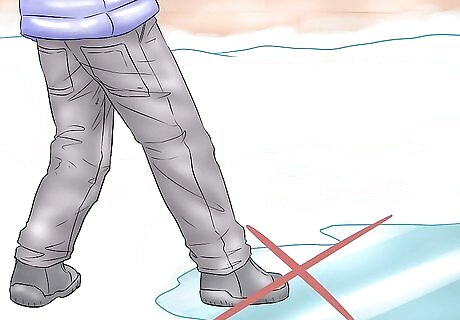
Do not run out onto the ice. Would-be rescuers frequently become victims when they fall through the ice as well. You should avoid approaching the hole in the ice unless the victim is unconscious or in imminent danger of slipping into the water and drowning, either from weakness or an inability to swim. If you do have to approach the hole as a last resort, then you should still not run or walk, but crawl, to minimize the impact of the weight.

Call for help. Dial your country's emergency number (Call the Emergency Services), or your local emergency dispatcher to have trained rescuers/paramedics sent to the scene. However, you should do this very quickly, and not leave the victim at any cost. If you waste time calling for help instead of helping the victim, the consequences will be dire.
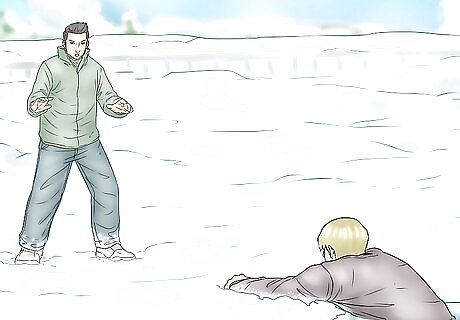
Tell the victim to remain calm. If the victim just fell in and remains conscious, he or she can most likely get out without physical assistance. Tell the victim to keep calm. Reassure the person that you know what to do and that you will come to them if necessary. Let them know, truthfully, that as long as they stay afloat, they have plenty of time. They'll experience a "cold shock" for the first 1-3 minutes, during which they'll hyperventilate, so the important thing is for the person to keep their head above water. Encourage the victim to control his breathing to stay calm. They will most likely be hyperventilating. Advise them to take deep, slow breaths through pursed lips.
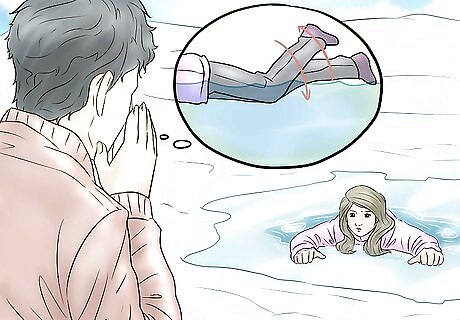
Tell the victim how to escape. Tell the person to swim to the edge of the ice and use their elbows to lift themselves partially out of the water. Have them go to the edge of the ice where they coming from, since it held their weight up until that point, whereas the ice around the other edges might be weak. The weight of their wet clothes will probably make it impossible for them to lift themselves up out of the water––the main objective is for them to just get a grip on the edge of the ice, so don't let them waste energy trying to pull themselves out. If they have any keys or sharp objects to use as picks, especially ice picks, encourage them to use them to get a grip on the ice. Instruct the victim to kick his/her legs and to try to get as horizontal as possible while using their upper body to drag themselves out. They should kick their legs as they would if they were swimming and come out of the hole in a horizontal position, with their belly on the ice. Once the victim is out of the water, they should roll away from the hole to minimize the impact of their weight on the ice.
Pulling the Victim Out

Throw a long object toward the victim. If the victim cannot get out on their own and help has not arrived, you should throw a long object that the victim can hold on to, such as a pole, a rope, a tree limp, or even a long scarf. Connecting yourself with the drowning person with a long object will keep you out of harm's way. Once the object reaches the victim, they should wrap it around themselves as much as they can. To increase the chances of a safe ice rescue, you should be prepared with rope and other long items if you plan on going onto the ice. Get a rope, extension cord, hockey stick, or any other sort of strong line that you can find. Since the victim's cold hands may not be able to grip the line, tie a loop (not a slip knot—preferably a bowline knot) at the end of the rope and tell them to put their arms through the loop and then bend their arms to touch their shoulders so that the rope is inside the bend of their elbows. Alternatively, they can put the loop over their head and slide it down under their arms.
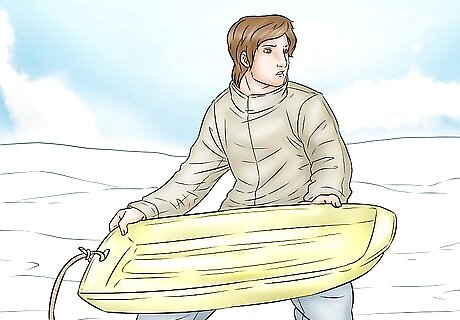
Throw the victim a sled if you don't have a long object. A sled, a life preserver tied to a rope, or any object for the victim to grab onto will be more helpful than nothing.
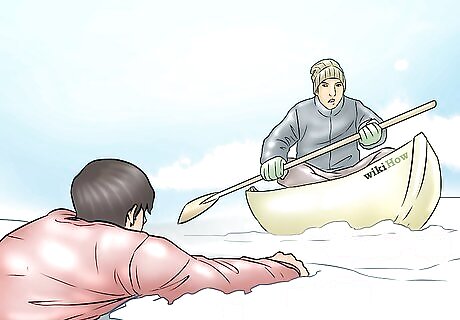
Row toward the victim if you don't have any objects. If you happen to have a light boat that you can push across the ice ahead of you, you should push it to the edge of the hole, get into it, and then pull the victim over the bow, making sure that it doesn't capsize. Attaching rope to the boat so the boat can more easily be brought to the shore by other rescuers isn't a bad idea if there's some rope nearby.
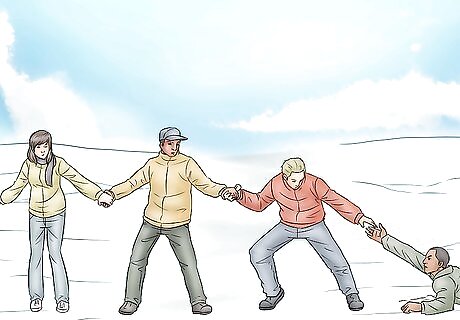
Form a human chain if it's necessary. If you don't have any rescue devices but you're with multiple people, then you may need to make a human chain to rescue the individual. To do this, you'll need to have the rescuers lie on the ice as closely as they can, forming a chain by holding on to the ankles of the person in front of him or her. The person at the front of the chain, who is closest to the victim, should grab the victim by their hands and should pull them flat onto the ice while the person at the end of the chain pulls the chain back. Though the human chain is not ideal, it's far better than having one person trying to help the victim who is in danger of falling in because they have no back-up. If the person in the front of the chain also falls in, they'll have the support of the person holding onto their ankles.
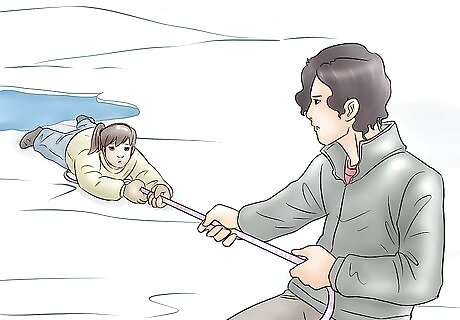
Pull the victim out. Stay low, stay off the thin ice, and pull hard. If you have helpers, have them use their strength to assist with pulling and with staying away from the thin ice. Whether you're pulling the person as the lead in a human chain or you're pulling them up with the help of a rope, the victim should be dragged across the ice instead of being lifted and carried. Remain at a safe distance from the weak ice, and keep a strong grip on the rope or object. If you must approach, always spread your weight as much as possible. At a minimum, if you don't have any objects to throw, crawl on your belly––never walk. Another easy way to move with your weight spread out is to lay down with your hands above your head and roll on the ice. If you do pull the victim out with a rope or another long object, make sure that you're pulling the victim toward you, and not the other way around.
Keeping the Victim Safe

Perform CPR if necessary. If the victim has stopped breathing or has no pulse, either from drowning or from sudden cardiac arrest, perform CPR on the victim if you know how. Do not attempt it if you don't know how to do it, but keep yelling for help if help has not come yet to maximize your chances of finding someone who knows how to do CPR. Even if the person appears to be dead, do not give up. Icy water can lower body temperature and slow down body functions, and just because the person isn't moving or responding doesn't mean they aren't alive and in need of help.

Warm the victim. If the victim is breathing and conscious, bring him or her inside or somewhere warm. They may need to be treated for shock as soon as possible. Remove wet clothes and immerse the person in lukewarm water that's no warmer than 90° Fahrenheit, 32° Celsius at first; gradually warm the water up later. Immersing a victim of hypothermia in water that is too warm can cause dangerous heart rhythms. If warm water is not immediately available, wrap the person in blankets. Though you may think that giving the person something warm to eat or drink will help him or her, you should not give any food or drink to a person who is still in shock and unable to eat or drink.

Get the victim medical attention as soon as possible. Even if the victim feels fine, he or she should still be examined by a medical professional. Though you have rescued the victim from the ice, you're not out of the woods quite yet. The repercussions of falling through ice, even for a few minutes, can be deadly. The person may be suffering from frostbite or a number of other complications.

Avoid future falls by always checking the thickness of the ice around you. If you want to prevent future falls through the ice, you should always know the thickness of the ice where you'll be fishing, walking, snowboarding, or doing whatever it is you do on the ice. You can check the thickness of the ice by using an ice chisel, ice auger, cordless drill, or tape measure, and by calling the local bait shop or lakeside resort to ask about the ice conditions in the area. Here are the appropriate thicknesses for each activity: 2" (5 cm) or less: Stay off the ice. The ice is too thin and won't support your weight. 4" (10 cm): appropriate for ice fishing or other on-foot activities. 5" (12.5 cm): okay for a snowmobile or ATV. 8" - 12" (20.5 - 30.5 cm): okay for a car or a small pickup. 12" - 15": (20.5 - 38 cm) appropriate for a medium-sized truck.




















Comments
0 comment